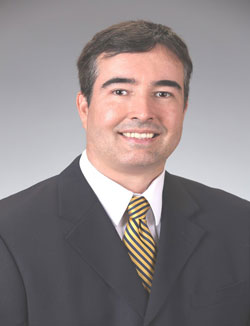At-home brain stimulation for depression is safe and effective

A device that delivers direct stimulation to the brain was found to be a safe and effective means of treating depression at home, according to a new study by researchers at UTHealth Houston; the Institute of Psychiatry, Psychology & Neuroscience at King’s College London; and the University of East London.
The research was published in Nature Medicine in October.
Transcranial direct current stimulation (tDCS) is a form of noninvasive brain stimulation that applies a weak, direct current of between 0.5 to 2 milliampere to the scalp via two electrodes. It is already commonly used in clinics to treat conditions such as psychosis and eating disorders. The clinical trial assessed tDCS that was used in a home setting and self-administered by patients.
King’s College London led the international study. Co-author and lead investigator for the U.S. site was Rodrigo Machado-Vieira, MD, PhD, MSc, professor with the Louis A. Faillace, MD, Department of Psychiatry and Behavioral Sciences.
“The results from this study, which tested home-based tDCS, may represent an important advance in the mood disorders field for improving feasibility and therapeutic response with this new neuromodulation modality,” Machado-Vieira said. “These latest results confirmed a positive profile for safety and efficacy similar to early studies with patients with depression and bipolar disorder, and the home-based therapy may facilitate access of this treatment to a larger number of patients.”
The study included 174 adult participants with a diagnosis of severe to moderate depression. They were randomly assigned to one of two treatment arms: active tDCS or inactive tDCS, which used the same device but did not provide a current. Participants had a 10-week course of treatment, with five 30-minute sessions a week for the first three weeks, followed by three 30-minute sessions a week for the following seven weeks.
Researchers found that participants in the active arm of the trial showed significant improvements in the severity of their depression, as well as an overall clinical response and remission, compared to those in the inactive placebo control arm. The rates of treatment response and remission were three times higher in the active treatment arm compared to the placebo arm, with 44.9% in the active arm demonstrating a remission rate compared to 21.8% of the control group.
“The burden of depression is mostly keenly felt by the 280 million people worldwide currently managing symptoms. While a combination of antidepressants and therapy generally proves to be effective for many people, medication can have side-effects that some can find disruptive. Our study has demonstrated that tDCS is a potential first-line option that could help those in need,” said Cynthia Fu, MD, PhD, the study’s senior author and a professor of affective neuroscience and psychotherapy at King’s College London.
“There is no such thing as the perfect medical intervention. Medication can have unintended side effects, while therapy is both time- and resource-intensive. Our hope is that tDCS can provide a viable third alternative for people with moderate to severe depression to help them better manage their symptoms,” said Rachel Woodham, MSc, the study’s first author and a research assistant at the University of East London.
“This breakthrough publication crowns the eight years of work that has been done by the fantastic team at Flow and the team of researchers at King’s College London, UTHealth Houston, and the University of East London, who led the study. Nature Medicine is one of the top medical journals in the world, and this publication speaks to the quality of the study design and results. Our core mission was, and still is, to create a treatment that is effective, safe, and accessible to as many people as possible,” said Daniel Månsson, chief clinical officer and co-founder of Flow Neuroscience, which funded the study.
UTHealth Houston co-author and co-lead investigator for the U.S. site was Jair Soares, MD, PhD, professor and the Pat R. Rutherford, Jr. Chair in Psychiatry in the Louis A. Faillace, MD, Department of Psychiatry and Behavioral Sciences.
“The study results bring promise that an innovative treatment modality may become available for patients suffering from mood disorders some time in the near future,” Soares said.